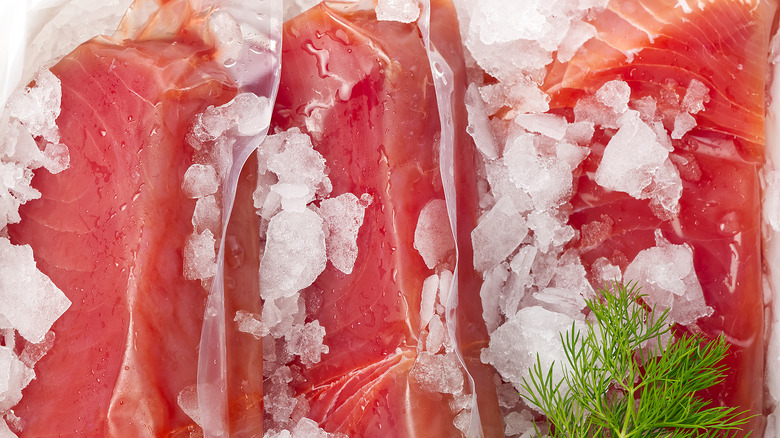What You Need To Know Before Freezing Tuna
Tuna is meaty, rich in flavor, and high in healthy omega-3 fatty acids, vitamins, and minerals. BBC Good Food recommends purchasing tuna when it is as fresh as possible. If you are in doubt about how fresh the tuna is, Fine Cooking suggests giving it a whiff. Fresh fish should smell like the sea, not fishy or stale. In addition, the color of tuna should be deep red or pink, moist, and almost translucent. The fish should never appear wet or soggy. Signs of aged fish are brown spots, a matte finish, and dullness. You should pass on these oxidized cuts of tuna – they are not fresh.
Tuna is a delicate meat, and to ensure it remains of the highest quality, it must be prepped before freezing. According to Pantry Tips, tuna freezes quite well if it is kept at a consistent temperature. Here are several important factors to consider before freezing tuna.
Divide the fish into portions
There are a few tips you need to know before freezing fresh tuna fish. Freezing the fish properly ensures it remains fresh and tastes great. Freeze It recommends four easy steps for freezing tuna. First, you must divide the fish into portions. Doing this makes meal prep more efficient later on. Moreover, it's much easier to defrost and prepare a personalized amount of tuna rather than the entire bulk of the fish.
If you plan on freezing a whole tuna fish, Pantry Tips says you must gut, clean, and dry it first. When freezing pieces of cut tuna, pat them dry to prevent ice crystals from forming on the fish, then proceed with the remaining prep steps. If you are freezing tuna steaks, Pantry Tips suggests soaking the tuna in a solution of ascorbic acid crystals, or salt, and water (which acts as a preservative) for about 20 seconds.
Wrap the tuna tightly and bag it up
After dividing the fish into portions, wrap it tightly in plastic wrap and squeeze it to remove the air. Freeze It says to double wrap the tuna in two sheets of cling wrap to prevent air from coming into contact with the fish. This step is essential for preventing freezer burn caused by oxygenation.
Our Everyday Life explains that freezer burn can quickly develop on tuna that's not wrapped properly. What does freezer burn look like? It is noticeable as grayish-brown patches, and this causes the meat to become hard in texture and alters the flavor. Our Everyday Life says that if your tuna becomes tainted with freezer burn, simply remove the areas by cutting them away before cooking. Large areas of freezer burn may ruin the entire piece of fish, in which case it's better to discard the tuna. Freeze It recommends bagging the tuna after wrapping it in cling wrap. Place the plastic-wrapped tuna into air-tight containers or large resealable plastic bags. This ensures the tuna remains as fresh as possible and helps further prevent freezer burn.
Label the tuna and freeze
Chat Elaine recommends labeling the bags with a permanent marker, which will withstand the temperature and moisture of the freezer. Label the bags with the date you place them in the freezer and the date on which they should be removed and discarded. You can also make notes on how to cook the tuna and what type of fish it is (steak, canned, or fresh). It's easy to lose track of the items in your freezer, but Chat Elaine says these tips should help keep you organized and prevent forgetful mistakes later.
How long can you keep tuna in the freezer? Still Tasty says that tuna can be kept for two to three months when stored properly. Defrosted tuna can be kept in the fridge for one to two days before cooking. It must, however, be cooked immediately if you thawed the tuna in cold water or a microwave. After cooking, tuna leftovers can be kept in the fridge for three to four days, and for up to four months in a freezer.



